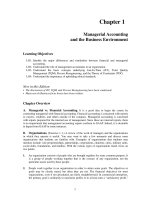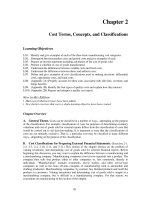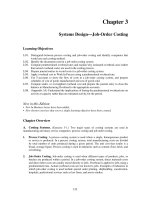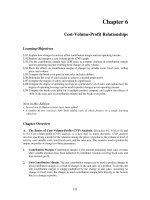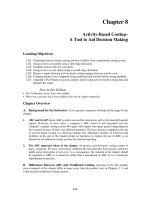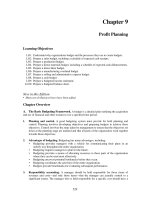Overview managerial accounting chapter 07
Bạn đang xem bản rút gọn của tài liệu. Xem và tải ngay bản đầy đủ của tài liệu tại đây (1.67 MB, 53 trang )
Chapter 7
Variable Costing—A Tool for Management
Learning Objectives
LO1. Explain how variable costing differs from absorption costing and compute unit product
costs under each method.
LO2. Prepare income statements using both variable and absorption costing.
LO3. Reconcile variable costing and absorption costing net operating incomes and explain
why the two amounts differ.
LO4. Understand the advantages and disadvantages of both variable and absorption costing.
New in this Edition
• Additional exercises have been created.
Chapter Overview
A. Overview of Variable and Absorption Costing. At least two methods can be used
in manufacturing companies to value units of product for accounting purposes—absorption
costing and variable costing. These methods differ only in how they treat fixed manufacturing
overhead costs.
1.
Variable Costing. Variable costing includes only variable production costs in product
costs. Direct materials, direct labor and variable manufacturing overhead costs would
ordinarily be included in product costs under variable costing. Fixed manufacturing
overhead is not treated as a product cost under this method. Rather, fixed manufacturing
overhead is treated as a period cost and is charged against income each period.
2.
Absorption Costing. Absorption costing treats all production costs as product costs,
regardless of whether they are variable or fixed. Under absorption costing, a portion of
fixed manufacturing overhead is allocated to each unit of product.
B. Comparison of Absorption and Variable Costing. (Exercises 7-3, 7-5, 7-6, 7-8,
and 7-9.) When comparing absorption costing and variable costing income statements, a
number of points should be noted:
1.
Deferral of fixed manufacturing costs under absorption costing. Under absorption
costing, if inventories increase then a portion of the fixed manufacturing overhead costs
of the current period is deferred to future periods in the inventory account. When the
units are later taken out of inventory and sold, the deferred fixed costs flow through to
the income statement as part of cost of goods sold.
395
2.
Differences in inventories under the two methods. The ending inventory figures
under the variable costing and absorption costing methods are different. Under variable
costing, only the variable manufacturing costs are included in inventory. Under
absorption costing, both variable and fixed manufacturing costs are included in
inventory.
3.
Suitability for CVP analysis. An absorption costing income statement is not well suited
for providing data for CVP computations since it makes no distinction between fixed and
variable costs. In contrast, the variable costing method classifies costs by behavior and is
very useful in setting-up CVP computations.
C. Extended Comparison of Income Data. (Exercises 7-2 and 7-6.) Exhibit 7-3 in the
text presents a comparison of absorption costing and variable costing income statements over
three years in which production is constant but sales vary. Exhibit 7-6 in the text also presents
comparative income statements over three years but holds annual sales constant and varies
annual production. From these Exhibits, several generalizations can be drawn. (All of these
generalizations assume the LIFO inventory flow assumption is being used. The
generalizations may not hold in some rare cases if a company uses an inventory flow
assumption other than LIFO.)
1.
Production equals sales (no change in inventories). When production equals sales,
inventories do not change. If inventories do not change, then there is no change in the
fixed manufacturing overhead costs in inventories under absorption costing. Therefore,
under both costing methods all of the current fixed manufacturing overhead will flow
through to the income statement as an expense. In the case of absorption costing it will
be part of cost of goods sold. In the case of variable costing, it will be a period expense.
2.
Production exceeds sales (inventories increase). When production exceeds sales,
inventories grow. If inventories grow, then some of the current fixed manufacturing
overhead costs will be deferred in inventories under absorption costing. Since all of the
current fixed manufacturing overhead costs are expensed under variable costing, the net
operating income reported under absorption costing will be greater than the net
operating income reported under variable costing.
3.
Sales exceed production (inventories decrease). When sales exceed production,
inventories shrink. If inventories decrease, then some of the fixed manufacturing
overhead costs that had been deferred in inventories in previous periods will be released
to the income statement as part of cost of goods sold as well as all of the current fixed
manufacturing overhead costs. Since only the current fixed manufacturing overhead
costs are expensed under variable costing, the net operating income reported under
absorption costing will be less than the net operating income reported under variable
costing.
4.
Long-term differences in income. Over an extended period of time, the cumulative net
operating income figures reported under absorption costing and variable costing will be
about the same; they will differ only by the amount of fixed manufacturing overhead
cost in ending inventories under absorption costing. Cumulative net operating income
figures will be identical whenever ending inventories are reduced to zero.
5.
Changes in production volume. Variable costing net operating income is not affected
by changes in production volume. On the other hand, absorption costing net operating
396
income is affected by changes in production volume. For any given level of sales, net
operating income under absorption costing will increase as the level of output increases
and hence inventories increase.
D. The Matching Principle. Accountants and managers have been arguing for decades
concerning the relative merits of absorption and variable costing. In practice, absorption
costing is used far more than variable costing even for internal reports. The reasons for this
are not entirely clear, although the perception that absorption costing is required for external
reporting undoubtedly plays a key role. The argument for using absorption costing in external
reports seems to be based on the matching principle.
1.
Argument for absorption costing. Advocates of absorption costing argue that all
manufacturing costs must be assigned to units of product so as to properly match costs
with revenues. They argue that fixed manufacturing overhead costs are essential to the
production process and must be included when costing units of product, regardless of
how the cost behaves.
2.
Argument for variable costing. Advocates of variable costing argue that fixed
manufacturing overhead costs are incurred in order to have the capacity to produce.
Moreover, they will be incurred regardless of whether anything is actually produced.
Since these costs are not caused by any particular unit of product and are incurred to
provide capacity for a particular period, the matching principle would dictate that fixed
manufacturing overhead costs must be expensed in the current period.
E. Advantages of the Contribution Approach. (Exercises 7-4 and 7-7.) There are a
number of advantages to using variable costing (and the contribution approach) in internal
reports and analysis.
1.
More useful for CVP analysis. Variable costing statements provide data that are
immediately useful for CVP analysis since they categorize costs on the basis of their
behavior. In contrast, it is often difficult to rework absorption costing data so that they
can be used in CVP analysis and in decisions.
2.
Income is not affected by changes in production volume. Under absorption costing,
reported net operating income is affected by changes in production since fixed costs are
spread across more or fewer units. This can distort income and may even result in
income moving in an opposite direction from sales. This does not occur under variable
costing.
3.
Avoids misunderstandings concerning unit product costs. Absorption costing unit
product costs can be easily misinterpreted as variable costs since they are stated on a per
unit basis. Such a misperception can lead to serious errors in making decisions. Variable
costing avoids this problem since unit costs include only variable costs.
4.
Fixed costs are more visible. The impact of fixed costs on profits is emphasized
because the total amount of such costs for the period appears separately and is
highlighted in the income statement rather than being buried in cost of goods sold and
ending inventory.
397
5.
Understandability. Managers should find it easier to understand variable costing
reports because data are organized by behavior and because variable costing is much
closer to cash flow.
6.
Control is facilitated. Variable costing ties in with cost control methods such as
flexible budgets.
7.
Incremental analysis is more straight-forward. Variable cost corresponds closely
with the current out-of-pocket expenditure necessary to produce and sell products and
services and can therefore be used more readily in incremental analysis than absorption
costing data. And since variable costing net operating income is closer to net cash flow
than absorption costing net operating income, it is likely to be more useful to companies
that have cash flow problems.
However, variable costing is not generally accepted by auditors for external financial reports
and is not permitted by the IRS in the United States and by tax authorities in many other
countries for income tax calculations. There is some question about whether variable costing
is actually prohibited in the United States by official pronouncements and some companies do
use some form of variable costing in their external reports, but absorption costing must be
considered the most generally accepted practice.
F. Impact of JIT Inventory Methods. When companies use JIT methods for
controlling their operations, the distortions of income that can occur under absorption costing
largely (or completely) disappear.
1.
The cause of distortions in net operating income. Erratic movements in net operating
income under absorption costing and the differences in net operating income between
absorption and variable costing can be traced to changing levels of inventory. When
inventory levels are constant or negligible, absorption costing and variable costing
methods yield the essentially same net operating income.
2.
The JIT solution. Under an ideally functioning JIT system, goods are produced strictly
to customers’ orders. Finished goods inventories almost disappear and work in process
inventories are kept to a minimum. With little or no inventories, fixed manufacturing
overhead costs cannot be shifted between periods under absorption costing. As a result,
both variable and absorption costing will show essentially the same net operating
income figure, and the net operating income under absorption costing will move in the
same direction as movements in sales.
398
Assignment Materials
Assignment
Exercise 7-1
Exercise 7-2
Exercise 7-3
Exercise 7-4
Exercise 7-5
Exercise 7-6
Exercise 7-7
Exercise 7-8
Exercise 7-9
Problem 7-10
Problem 7-11
Problem 7-12
Problem 7-13
Problem 7-14
Problem 7-15
Problem 7-16
Problem 7-17
Case 7-18
Case 7-19
Case 7-20
Level of
Topic
Difficulty
Variable and absorption unit product costs ...............................
Basic
Variable costing income statement; explanation of
difference in net operating income.......................................
Basic
Reconciliation of absorption and variable costing net
operating incomes ................................................................
Basic
Evaluating absorption and variable costing as alternative
costing methods.................................................................... Medium
Variable and absorption costing unit product costs and
income statements ................................................................
Basic
Variable costing income statement; reconciliation ...................
Basic
Inferring costing method; unit product costs ............................
Basic
Variable costing unit product cost and income statement;
break-even ............................................................................
Basic
Absorption costing unit product cost and income statement.....
Basic
Variable and absorption costing unit product costs and
income statements; explanation of difference in net
operating income..................................................................
Basic
Variable costing income statement; reconciliation ...................
Basic
Absorption and variable costing; production constant, sales
fluctuate................................................................................ Medium
Comprehensive problem with labor fixed................................. Medium
Preparation and reconciliation of variable costing statements .. Medium
Variable costing statements; sales constant, production
varies; JIT impact................................................................. Difficult
Incentives created by absorption costing; ethics and the
manager ................................................................................ Difficult
Prepare and interpret statements; changes in both sales and
production; JIT impact ......................................................... Difficult
Absorption and variable costing; uneven production; breakeven analysis; JIT impact ..................................................... Difficult
Ethics and the manager; absorption costing income
statements............................................................................. Difficult
The case of the plummeting profits........................................... Difficult
Suggested
Time
15 min.
30 min.
20 min.
30 min.
30 min.
20 min.
20 min.
30 min.
20 min.
45 min.
30 min.
60 min.
45 min.
45 min.
45 min.
30 min.
75 min.
90 min.
120 min.
90 min.
Essential Problems: Problem 7-10 or Problem 7-13, Problem 7-11, Problem 7-14
Supplementary Problems: Problem 7-12, Problem 7-15, Problem 7-16, Problem 7-17, Case 7-18,
Case 7-19, Case 7-20
Linked problems and exercises:
Exercise 7-9 should be assigned after Exercise 7-8
Exercise 7-2 should be assigned after Exercise 7-1
399
1
2
400
Chapter 7
Lecture Notes
Helpful Hint: Before beginning the lecture, show
students the fifth segment from the first tape of the
McGraw-Hill/Irwin Managerial/Cost Accounting video
library. This segment introduces students to many of
the concepts discussed in chapter 7. The lecture notes
reinforce the concepts introduced in the video.
1
I.
Chapter theme: Two general approaches are used for
valuing inventories and cost of goods sold. One approach,
called absorption costing, is generally used for external
reporting purposes. The other approach, called variable
costing, is preferred by some managers for internal
decision making and must be used when an income
statement is prepared in the contribution format. This
chapter shows how these two methods differ from each
other.
Overview of absorption and variable costing
2
A. Absorption costing (also called the full cost method)
treats all costs of production as product costs,
regardless of whether they are variable or fixed. Since
no distinction is made between variable and fixed costs,
absorption costing is not well suited for CVP
computations.
i.
The cost of a unit of product consists of
direct materials, direct labor, and both
variable and fixed overhead.
401
2
402
ii.
Variable and fixed selling and administrative
expenses are treated as period costs and are
deducted from revenue as incurred.
B. Variable costing (also called direct costing or
marginal costing) treats only those costs of production
that vary with output as product costs. This approach
dovetails with the contribution approach income
statement and supports CVP analysis because of its
emphasis on separating variable and fixed costs.
i.
2
The cost of a unit of product consists of
direct materials, direct labor, and variable
overhead.
Helpful Hint: For simplicity, nearly all examples,
exhibits, problems, and exercises in this chapter treat
direct labor as a variable cost. However, students
should be reminded that labor is essentially a fixed cost
in some companies. This is a growing phenomenon as
pointed out in earlier chapters. Under variable costing,
direct labor would not be included in product costs
when it is a fixed cost. This point is reinforced in the
discussion on theory of constraints at the end of the
chapter.
“In Business Insights”
To piggyback on the Helpful Hint above, there are
many companies that treat direct labor as a fixed cost.
For example:
“Direct Labor – A Fixed Cost in China” (page 280)
403
2
3
5
6
404
4
2
• The Shanghai Bund Steel Works (SBSW) of the
Peoples’ Republic of China is a large state-owned
enterprise.
• In such an enterprise, management has very little
freedom to adjust the work force – eliminating
jobs would create political problems.
• Therefore, for internal management purposes,
SBSW treats labor cost as part of fixed
manufacturing overhead.
ii.
Fixed manufacturing overhead, and both
variable and fixed selling and administrative
expenses are treated as period costs and
deducted from revenue as incurred.
Helpful Hint: Emphasize that the only difference between
variable and absorption costing is in how the two methods
treat fixed manufacturing overhead costs. Also, emphasize
that under both methods, selling and administrative costs
are period costs and are not product costs.
3-4
Quick Check – absorption vs. variable costing
C. Unit cost computations
5
i.
Assume Harvey Company produces a single
product with available information as shown.
ii.
The unit product costs under absorption and
variable costing would be $16 and $10,
respectively.
6
1. Under absorption costing, all production
costs, variable and fixed, are included when
determining unit product cost.
405
6
7
406
8
2. Under variable costing, only the variable
production costs are included in product
costs.
6
Helpful Hint: Before beginning the forthcoming income
comparisons, remind students of the relationship
between ending inventory and net operating income.
Higher ending inventory results in higher net operating
income since costs of goods available for sale less
ending inventory equals cost of goods sold. Therefore, a
higher ending inventory results in a lower expense (cost
of goods sold) deducted to arrive at net operating
income.
II.
Income comparison of absorption and variable costing
A. The Harvey Company example continued:
i.
1. 20,000 units were sold during the year.
2. The selling price per unit is $30.
3. There is no beginning inventory.
7
ii.
8
Additional assumptions:
Absorption costing
1. The unit product cost is $16.
2. The fixed manufacturing overhead cost
deferred in inventory is $30,000 (5,000
units × $6 per unit).
3. The net operating income is $120,000.
Helpful Hint: Explain that under absorption costing,
the recognition of fixed costs as an expense is really a
timing issue. When the items are sold, the fixed costs
407
9
10
408
11
will be reflected on the income statement as part of cost
of goods sold.
iii.
1. The unit product cost is $10.
2. All $150,000 of fixed manufacturing cost is
expensed in the current period.
3. The net operating income is $90,000.
9
iv.
10
11
Variable costing.
Comparing the two methods.
1. Under absorption costing, $120,000 of fixed
manufacturing overhead is included in cost
of goods sold and $30,000 is deferred in
ending inventory as an asset on the balance
sheet.
2. Under variable costing, the entire $150,000
of fixed manufacturing overhead is treated
as a period expense.
a. The variable costing ending inventory
is $30,000 less than absorption
costing, thus explaining the difference
in net operating income between the
two methods.
3. The difference in net operating income
between the two methods ($30,000) can also
be reconciled by multiplying the number of
units in ending inventory (5,000 units) by
the fixed manufacturing overhead per unit
($6) that is deferred in ending inventory
under absorption costing.
409
12
13
15
410
14
III. Extended comparisons of income data
A. The Harvey Company example continued:
i.
1. 30,000 units were sold in year 2.
2. The selling price per unit, variable costs per
unit, total fixed costs, and number of units
produced remain unchanged.
3. 5,000 units are in beginning inventory.
12
ii.
Unit cost computations
1. Since the variable costs per unit, total fixed
costs, and the number of units produced
remained unchanged, the unit cost
computations also remain unchanged.
13
iii.
Absorption costing
1. The unit product cost is $16.
2. The fixed manufacturing overhead cost
released from inventory is $30,000.
3. The net operating income is $230,000.
14
iv.
15
Additional assumptions/facts:
Variable costing
1. The unit product cost is $10.
2. All $150,000 of fixed manufacturing
overhead cost is expensed in the current
period.
3. The net operating income is $260,000.
411
16
17
412
18
v.
Comparing the two methods
1. The difference in net operating income
between the two methods ($30,000) can be
reconciled by multiplying the number of
units in beginning inventory (5,000 units)
by the fixed manufacturing overhead per
unit ($6) that is released from beginning
inventory under absorption costing.
2. Across the two year time frame, both
methods reported the same total net
operating income ($350,000). This is
because over an extended period of time
sales cannot exceed production, nor can
production much exceed sales. The shorter
the time period, the more the net operating
income figures will tend to differ.
16
17
B. Summary of key insights
i.
When production is greater than sales, as in
year 1 for Harvey, absorption income is
greater than variable costing income.
ii.
When production is less than sales, as in
year 2 for Harvey, absorption costing
income is less than variable costing income.
iii.
When production equals sales, the two
methods report the same net operating
income.
18
413
414
“In Business Insights”
The relationship between production and sales can
have a significant impact on the net operating income
of companies that use absorption costing. For example:
“Chainsaw Al Dunlap’s Legacy at Sunbeam” (page
287)
• Al Dunlap was hired to turn around Sunbeam
Corp. with his well-known cost-cutting and
disregard for the welfare of existing employees.
• Three years later, Dunlap left a legacy of
questionable accounting practices and excess
inventories.
• Dunlap’s successors complain that eliminating
those excess inventories has required the
company to keep production levels well under
capacity.
• Since Sunbeam uses absorption costing,
liquidating these excess inventories has depressed
the company’s profits.
“The Perverse Effects of Absorption Costing at Nissan”
(page 289)
• Nissan North America liked to run its factories at
capacity, regardless of how well cars were
selling, because under absorption costing it
would help the factories generate a profit.
• As a consequence, Nissan dealers had to slash
prices and offer big rebates to sell their cars.
• According to Fortune magazine, “Years of
discounting and distress sales seriously undercut
the value of the Nissan brand. While Toyota
stood for quality, customers came to Nissan to
get a better deal.”
415
19
20
416
IV. Effect of changes in production on net operating income
A. The Harvey Co. example revisited
i.
Overview of revised example:
1. In the previous Harvey Co. example:
a. Units of production was constant.
b. Sales in units fluctuated.
2. In the forthcoming example:
a. Units of production will fluctuate.
b. Sales in units will remain constant.
19
Helpful Hint: To emphasize the key point of the
forthcoming example, ask students how absorption
costing net operating income can be increased or
decreased without changing sales. The answer is by
altering production since increasing or decreasing
ending inventories results in a net deferral or a net
release of fixed manufacturing overhead costs.
ii.
20
Harvey Co. year 1 data:
1.
2.
3.
4.
30,000 units are produced.
25,000 units are sold.
There is no beginning inventory.
The selling price per unit, variable costs per
unit, and total fixed costs remain
unchanged from the prior example.
417
21
22
24
418
23
iii.
21
1. The unit product costs under absorption and
variable costing would be $15 and $10,
respectively.
iv.
Absorption costing: year 1
1. The unit product cost is $15.
2. The fixed manufacturing overhead cost
deferred in inventory is $25,000.
3. The net operating income is $200,000.
22
v.
Variable costing: year 1
1. The unit product cost is $10.
2. All $150,000 of fixed manufacturing
overhead cost is expensed in the current
period.
3. The net operating income is $175,000.
23
vi.
24
Unit cost computations: year 1
Harvey Co. year 2 data:
1. 20,000 units are produced.
2. 25,000 units are sold.
3. There are 5,000 units in beginning
inventory.
4. The selling price per unit, variable costs per
unit, and total fixed costs remain
unchanged.
419
